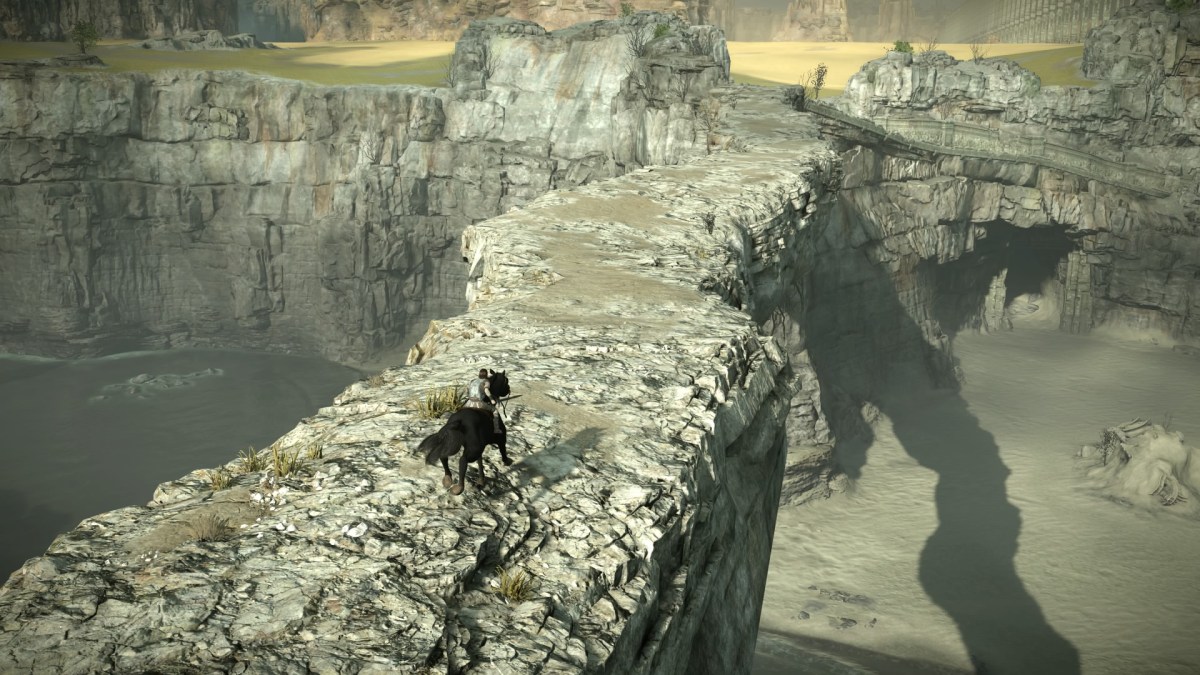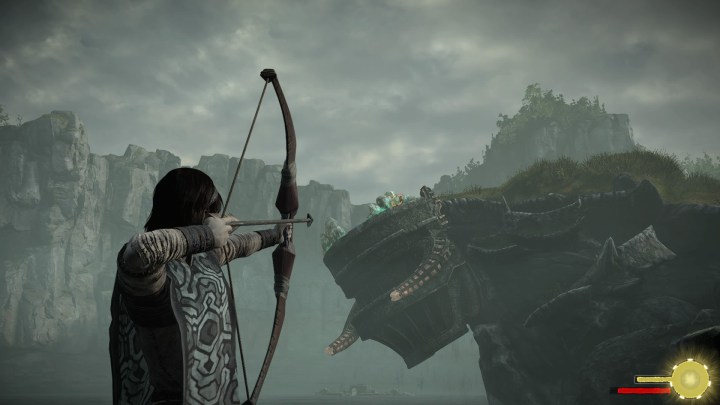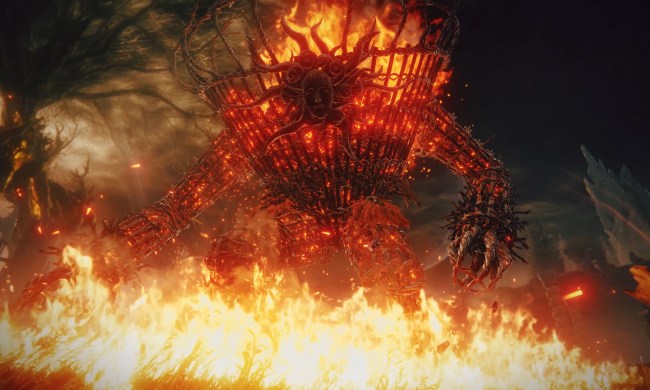“Veterans and newcomers alike will fall for 'Shadow of the Colossus' the moment they see it in motion.”
- Full remake is hyper-detailed and gorgeous.
- Photo mode takes advantage of great visuals.
- New collectibles give an incentive to wander the world again.
- Classic gameplay and story remain powerful 13 years later.
- Camera feels like a PlayStation 2 holdover.
- Extra modes help, but there's still not a ton to do.
Shadow of the Colossus‘ entrance onto the video game stage in 2005 shook players with the same impact that made its gargantuan creatures so amazing, and intimidating.
In Shadow, Sony’s Japan Team created a gorgeous, minimalist experience on the PlayStation 2, full of quiet moments and vast landscapes, punctuated with massive battles against overwhelmingly huge creatures. It challenged many of the ideas of what video games were and could be. It redefined scale, challenged players’ wit and intelligence rather than their twitch reflexes and button-pushing skills, and threw out a few conventions of gameplay and storytelling.
For Sony’s PlayStation 4 remake of Shadow of the Colossus, Japan Studio and developer Bluepoint Games rebuilt the game from the ground up, refreshing the visuals so they will astound us the way the original did in more than a decade ago.
It is still very much the same game, however. While Shadow of the Colossus has not changed much, games and player have both evolved. As such, Shadow isn’t quite as impactful as it was back in 2005 (especially since it saw a PS3 re-release in 2011).
Stalking giants
Shadow of the Colossus’ relative simplicity is part of what makes it so fascinating. It opens with a young warrior on horseback riding into a strange, empty land, with the body of a young woman slung over the saddle. After a night’s ride, he arrives in a strange temple, where the disembodied voice of something known as Dormin speaks to him. The warrior, known as Wander, makes a bargain with Dormin. The spirit will bring the woman back to life if Wander will kill 16 huge creatures, the titular Colossi, that roam the otherwise empty land.
Without much discussion, Wander sets out, crossing the vast landscape on horseback. Before long he’s staring down a colossus, a living statue made of stone and furry flesh that stands several stories tall.

Taking down each colossus feels less like a boss you battle than a puzzle you solve. Though Wander has a sword, simply hacking at a Colossus does it little to no harm. Instead, each one has one or more glowing, magical weak points on its body, which he must find and stab to drain the Colossus’ health. They’re huge, so fighting the colossi means figuring out how to trick or injure them to create an opening for Wander to climb up their massive bodies.
Shadow of the Colossus challenged many of the ideas of what video games were and could be.
Wander has a stamina gauge that limits how high he can climb, and how long he can hold on. Much of your “fight” with each colossus comes down to managing Wander’s stamina as you wait for him to get his footing.
The way the game frames these battles helped make Shadow of the Colossus so impactful in 2005, and the years since. Some of the creatures are hostile when you engage them, but many ignore you, going about their lives until you attack them. Fighting them is an intense, high-energy experience, with music picking up in triumphant swings.
As you defeat them, though, Shadow takes on a much more somber quality. As the beauty and mystery of each colossus is lost, you feel a sense of regret. Each victory is paired with an inexplicable tinge of loss. It’s a complex and affecting experience that many developers have tried to crib from, but few have managed to replicate. It’s impressive that the game also tells an emotionally affecting story almost wholly through these battles.
New look, old game
Shadow of the Colossus was limited by the PlayStation 2 hardware when it was released, but Sony’s Japan Studio still managed to create into a visually astounding game, largely through the way its world is designed and presented. Shadow is cinematically composed, helping players find sweeping shots of Wander crossing the sweeping vistas on horseback, naturally framed with the horse off to one side. The very deliberate camera captures both the loneliness of the landscape, as well as the subtle beauty of a world in which nature is retaking the ruin of some past, lost civilization that’s left mostly unexplored.
The PlayStation 4 remake takes what was mostly left up to the imagination in the original and fills it in, adding a staggering amount of new detail to the game that injects new life into the world. The original Shadow was a line drawing. The remake is a painting.
Comparing this remake to the original PS2 version, you can see how much effort has been expended to render Shadow the way its creators likely envisioned from the start. The level of detail everywhere, from blades of grass, to crumbling temples and cities, to the stony, semi-living giant colossi themselves, is ridiculous — and obviously the result of a lot of painstaking effort.
Just wandering around Shadow of the Colossus on PS4 is a treat, and the game’s original design sensibilities, aimed at making a visually engrossing experience even as gameplay itself is minimal, works wonderfully with the graphical fidelity the PlayStation 4 can achieve. On a regular PlayStation 4, things look great; if you’ve got a PS4 Pro, you can run the game at 4K resolution if you’ve got the TV for it, or push the game up to 60 frames per second at the standard 1080p resolution.
The best part of the remake is that fans can take advantage of its visual upgrade with a new “Photo Mode.” With the touch of a button on the directional pad, players can freeze the action and move the camera around to take stills of the game, with the ability to mess with elements like color saturation and depth of field, or even to apply filters Instagram-style. Photo mode provides a good reason to spend time exploring and appreciating the work the developers have done to bring Shadow to this point, especially for fans eager to revisit the world.
Some old things can’t be new again
The visual upgrade of Shadow of the Colossus is stark, but other elements of the original haven’t seen the same amount of attention in the PS4 remake. In fact, most everything else about the game is solidly rooted in the PS2 era – in some cases, to the game’s detriment.
The original Shadow was a line drawing; the remake is a painting.
The camera, in particular, is a bit hinky, often getting stuck in corners in those moments when colossi fights take you into narrow squeezes or interior spaces. It can also struggle with the scope of the game — sometimes it’s hard to see what you’re doing as you climb aboard colossi, grappling with crossing terrain that’s moving beneath you as the camera can’t find a good middle ground between covering the huge creature and staying close enough to Wander that you can tell what you’re doing. You can control the camera with the right analog stick, but it will usually swing back to its default position on its own as soon as you let go of the controls, so you’ll spend a lot of time wrestling it while you try to get it to show you what you want to see.
Controlling Wander also feels a bit loose at times. Moving around the game world feels a little floaty and imprecise, which doesn’t matter until you’re in a place without much room to move around, like the back of an angry colossus. Coupled with the untrustworthy camera, you’ll sometimes get moments when trying to get Wander to make precise jump is a pain of pushing the camera into a good position and keeping him from accidentally stepping off a cliff instead.
It’s a double-edged sword. Shadow of the Colossus handles and feels pretty much exactly like the 2011 remaster and, by extension, the 2005 original. Considering the huge effort that went into making the game look its best, we wonder whether it would have been wise to modernize the controls and camera as well, even though that might have made the game feel less like it did when it was originally released. There’s an argument to be had about whether or not it’s better to remain true to the 2005 game’s mechanical feel, but not updating the controls and camera holds back Shadow from its true potential as a modern creation.
More to explore
Since there are no enemies to fight or levels to traverse, the main story of Shadow of the Colossus can be handled pretty quickly — as little as three or four hours, especially for those players who’ve taken the journey before. Like previous versions, the PlayStation 4 remake includes a new game plus and hard mode. There’s also a time attack mode that unlocks different weapons and items to use in the game, like a cloak that makes you invisible, and a mask that reduces the damage colossi deal out.
The PS4 remake also has an additional batch of collectibles hidden throughout the game, marked with a small flutter of golden particles that spray out of the ground to mark their locations, although it’s not clear yet what collecting more than a couple of them might do.
These small additions aside, don’t expect the PS4 version of Shadow to contain a lot of new or updated content; it doesn’t. It’s a remake made to modernize the look of the game. If you’ve played it before, though, and especially if you’ve bought it before, you won’t be getting much in the way of new stuff.
Our Take
More than a decade removed from its moment, Shadow of the Colossus might not be quite as impactful as it was, thanks to the influence it had on the gaming landscape. This remake is a nostalgic, loving recreation of an iconic game. It’s absolutely a world worth exploring, especially if this is your first chance.
Is there a better alternative?
Unless you want to play the original version for posterity, the PlayStation 4 version of Shadow of the Colossus is easily the best one. While Shadow has influenced other games, it remains a landmark title with nothing else quite like it.
How long will it last?
Powering through Shadow of the Colossus‘ 16 bosses will only take four or five hours; less if you’ve played the game before. Extra modes like time attack and new game plus will give fans more to do with the game, and a new batch of collectibles adds an incentive to explore Shadow‘s heavily detailed world. At most, there are 10-15 hours worth of content in this package.
Should you buy it?
Short answer? Yes. Shadow of the Colossus is still an excellent game. If you haven’t played, you should.
The question becomes slightly more complicated for returning players. This is a beautiful, painstaking remake of the original, but other than its visuals, there’s little here to revisit other than nostalgia for a great game. If the prospect of seeing the Colossi in PS4-level detail sounds exciting, you will not be disappointed.
We reviewed Shadow of the Colossus (PS4) using a retail copy of the game provided by the publisher.












